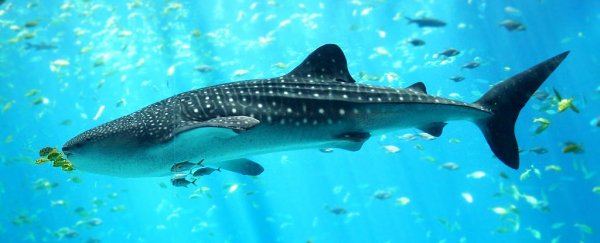Whale sharks like to take a long swim after they've left Ningaloo Reef in Australia's north-west where tourists get close while snorkelling.
The latest research, in the journal Pacific Conservation Biology, based on satellite-tracking and community sightings, shows whale sharks are distributed further along the coastline than previously thought.
"Everyone knows that whale sharks can be found at Ningaloo Reef between April and July every year," says Brad Norman from Murdoch University's Centre for Fish and Fisheries Research. "As filter feeders, it is where they find an abundance of food. But where they go to and where they come from has been a mystery until now."
The research by Murdoch University, ECOCEAN Inc, and the University of Queensland demonstrates that the expansive Western Australian coastline may provide other areas of critical importance for the threatened species.
"For the first time, the satellite tracking shows that they migrate to and from Ningaloo Reef, and it has helped us to identify that Shark Bay is another key area for them along the WA coast," says Norman. "At this stage we believe it's food related and they tend to congregate there late in the year."
Whale sharks are the largest known fish, growing to 12 metres and weighing up to 20 tonnes. They are filter feeders, with their diet mainly plankton, and popular attractions for divers.
 Roaming tracking of whale sharks. Satellite tracks of sharks. Image Copyright: Samantha Reynolds
Roaming tracking of whale sharks. Satellite tracks of sharks. Image Copyright: Samantha ReynoldsThe latest study over five years from 2010 to 2014 followed the movements of 13 satellite-tracked whale sharks at Ningaloo Reef. Individuals were recorded swimming north to the Kimberley and south to Perth.
The maximum distance travelled by one whale shark was more than 3,200 kilometres over 203 days. The project also used more than 8,000 sightings information on whale sharks from as far north as Ashmore Reef and as far south as Albany.
A 2012 study involving Murdoch University and Shandong University at Weihai found distressing trends in the catch and trade of threatened whale sharks in China.
Whale sharks are increasingly being targeted due to high demand for large shark fins and a rising appetite for shark meat. In 2014, an activist group uncovered a whale shark factory in China said to be processing up to 600 of the endangered fish each year.
The money-making product from whale sharks is the concentrated oil in the shark's liver which is used for skin care products and lipstick, as well as omega-3 health supplements.
This article was originally published by Business Insider.
More from Business Insider:
